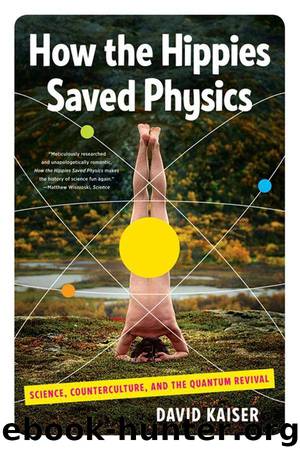How the Hippies Saved Physics: Science, Counterculture, and the Quantum Revival by Kaiser David

Author:Kaiser, David [Kaiser, David]
Language: eng
Format: epub
Publisher: W. W. Norton & Company
Published: 2011-06-26T20:00:00+00:00
A polarizing filter, such as the plastic often used in sunglasses, acts like a picket fence. Linearly polarized light, whose polarization axis lines up with the orientation of the filter, passes through unhindered; light waves whose polarization axis differs from the filter’s orientation by 90 degrees are blocked. That’s why polarized sunglasses allow you to avoid squinting at ocean waves while relaxing at the beach: most of the light reflected off the water is horizontally polarized, so the vertically polarized filters cut down on most of the glare. Circularly polarized light, meanwhile, can be broken down into equal parts horizontal and vertical (linear) polarization. When circularly polarized light shines on a polarizing filter, half of the light makes it through.
At the quantum level, polarization behaves much like electrons’ spin. Just as electrons can only exist in one of two spin states—either spin up or spin down along a given direction—photons, the tiny quanta that make up light waves, come in various polarization states. Physicists often abbreviate the states by their initials: H for horizontal linear polarization; V for vertical linear polarization; R for right-handed circular polarization; and L for left-handed circular polarization. Pairs of photons that emerge from a common source in a state of zero total angular momentum, as in Clauser’s experiments on Bell’s theorem, show perfect correlations. If one member of the pair is measured to be linearly polarized in the H state, then its companion must be linearly polarized in the V state (when measured along the same direction); if one photon is measured to be circularly polarized in the R state, then its twin must be circularly polarized in the L state.
All that was old hat by the time Nick Herbert began brainstorming about superluminal signaling. The basic ideas about polarized light had been around since the early nineteenth century—right from the dawn of the wave theory of light—and the application to individual photons had been postulated during the 1920s.27 What Herbert wanted was some way to exploit observable differences between individual H, V, R, and L photons; some property that could be used to encode messages between distant experimenters.
As luck would have it, Herbert stumbled across a handy volume of reprints not long after finishing his PhD at Stanford. His dissertation had been on nuclear physics, and by the time he wrapped up that work he had had his fill of the subject. He cast about for something new to think about and quantum optics caught his eye.28 Just a few years earlier, the American Association of Physics Teachers had bundled together some of the most important articles on the subject and republished them as Quantum and Statistical Aspects of Light. Included was an article dating all the way back to 1936 by a physicist working at Princeton who had managed to measure the angular momentum of circularly polarized light. That physicist, Richard Beth, had received some pretty impressive help: Beth thanked both Albert Einstein and Boris Podolsky for extensive discussions, just months after they had published their famous EPR article.
Download
This site does not store any files on its server. We only index and link to content provided by other sites. Please contact the content providers to delete copyright contents if any and email us, we'll remove relevant links or contents immediately.
The Complete Stick Figure Physics Tutorials by Allen Sarah(7134)
Secrets of Antigravity Propulsion: Tesla, UFOs, and Classified Aerospace Technology by Ph.D. Paul A. Laviolette(4973)
Thing Explainer by Randall Munroe(3782)
The River of Consciousness by Oliver Sacks(3409)
The Order of Time by Carlo Rovelli(3071)
How To by Randall Munroe(2911)
I Live in the Future & Here's How It Works by Nick Bilton(2839)
A Brief History of Time by Stephen Hawking(2818)
What If?: Serious Scientific Answers to Absurd Hypothetical Questions by Randall Munroe(2542)
The Great Unknown by Marcus du Sautoy(2532)
Midnight in Chernobyl by Adam Higginbotham(2384)
Blockchain: Ultimate Step By Step Guide To Understanding Blockchain Technology, Bitcoin Creation, and the future of Money (Novice to Expert) by Keizer Söze(2377)
Networks: An Introduction by Newman Mark(2264)
The Meaning of it All by Richard Feynman(2213)
Easy Electronics by Charles Platt(2204)
The Tao of Physics by Fritjof Capra(2162)
Midnight in Chernobyl: The Untold Story of the World's Greatest Nuclear Disaster by Adam Higginbotham(2074)
When by Daniel H Pink(2019)
Introducing Relativity by Bruce Bassett(2015)
